PIPE DREAMS AT SURF CAMP 2018

OVERCOMING
BRAIN FUNCTION CONFERENCE A SUCCESS FOR 4D LIVING LONELINESS

LIVE MORE Happy



BRAIN FUNCTION CONFERENCE A SUCCESS FOR 4D LIVING LONELINESS


Have you ever wondered if you’re living your best life? It’s easy to get bogged down in the day-to-day things we have to do and forget we should be doing more than just existing. When Jesus was on earth, He told people that He had come so they could have life and have it more abundantly (John 10:10). That’s something that encompasses all aspects of our being — spiritual, physical, emotional and mental.

In this issue of The Upside, we’re delving into the mental health aspect. Pastor David Stojcic shares ideas for dealing with loneliness (page 15); and there’s a
report about the first-ever Brain Function Conference run by 4D Living (pages 6 and 7).
We also have a fantastic feature from Dr Darren Morton, who’s a man on a happiness mission. He’s the author of Live More Active and Live More Happy, and has spent many years studying how the brain and body work to give us the best chance at a fantastic life. Read on to find out more about your Limbo and emotional wellbeing (pages 4 to 6)!

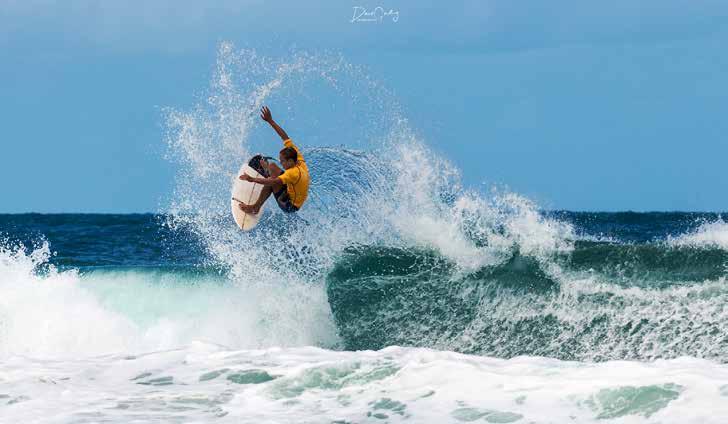
Surf Camp 2018 was just fantastic! It was held over the weekend 9 to 11 March at the Yarrahapinni Youth Centre on the New South Wales Mid-North Coast near Scotts Head — everyone who is familiar with this part of the world knows just how special and beautiful the beach, surf and landscape really are!

Our guest speaker this year was Robby Morgan — Robby is currently employed by the Seventh-day Adventist Church in Northern New South Wales and is working with the ARISE students at Kingscliff Adventist Church. He is passionate about God, and sharing His message of Salvation and love to all people.
God blessed our camp with great surf and awesome weather all weekend. Our surf competition ran from 7.00am on Sunday morning through to 2:30pm on Sunday afternoon, and was followed by the presentation of prizes and trophies in the chapel at the centre.
The little kids just love being part of the day, and receiving a prize in front of all their surfing peers and family. The teens, youth, women and “oldies” have a heap of fun showing they have what it takes to win a trophy — or at least make it out in the surf with mates. It is a weekend for everyone who enjoys good company, right next to the beach and ocean — even if contests are not your thing.
Surf Camp is an annual event organised by the Kingscliff Adventist Church and the North New South Wales Conference — next year it will be held 8 to 10 March at the same location. Come join us!

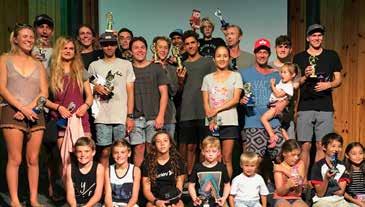 — Kevin and Darnelle Johnson
— Kevin and Darnelle Johnson
Want to find out more? Contact Kevin Johnson (Surf Camp Coordinator) via email — kevin@ceng.com.au — or mobile — 0411 550 001.
I’m Australian, and we Aussies are famous for shortening the names of everyone and everything — the names of the mascots for the Sydney Olympics were, unremarkably, Sid, Millie and Ollie.
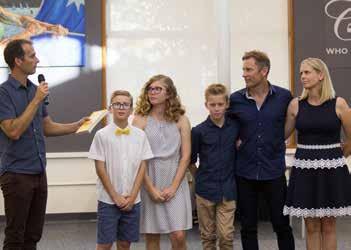
So, in the spirit of simplicity, let me introduce you to your Limbo. It’s the nickname I’ve given to the part of your brain referred to as the limbic system. It lives in the middle of your brain, just below the part that looks like a cauliflower, which I call the Leader. Your Limbo contains several structures, all with complicated names.* Among other things, it’s your home of happy — brain scientists refer to it as your “emotional brain” (Clark et al., 2010).
We’ve learnt a lot about the Limbo through the work of brain researchers who love to press buttons. They began by wiring up the Limbos of cats and rats to send a tiny electrical impulse to that part of the brain. Here’s what the researchers discovered when they pressed the button.
So the rats didn’t feel left out, the researchers stimulated one part of their Limbo and gave them the ability to press a button. The researchers watched in amazement as the rats repeatedly pressed the button, even in preference to eating and drinking. If left unchecked, the rats would have eventually died from exhaustion, albeit with their paws still poised on the button (Olds & Milner, 1954).
Feeling is the core business and mood the main gig of your Limbo, but it also has three other functions.
The researchers found if they stimulated one part of the cat’s Limbo, the cat would begin to purr and become playful. If they continued to stimulate the Limbo, the cat would lose all interest in food. Happy and thin — sounds appealing, doesn’t it? But the researchers also found if they moved the wires slightly and stimulated another part of the Limbo, the cat threw a hissy fit and ate anything it could get its paws on. Repetitive stimulation of the Limbo in this way caused the cat to morph into an obese, hostile fiend (MacLean & Delgado, 1953).
Have you ever met someone for the first time only to have their name vanish from your memory moments after they’ve told you? It’s more embarrassing when they clearly make a mental note of your name. This is why Dale Carnegie, author of How to Win Friends and Influence People, says the sweetest sound is the sound of your own name. Remembering a person’s name communicates care.
Do you remember the name of your first boy or girlfriend? I don’t remember much about Year 3, but I do remember the name of a certain girl in my class. I liked her and when I got to sit next to her in story time, my heart pounded.

Your Limbo decides whether to file or forget the information with which it comes into contact. It makes this decision based on how it feels.
Strong feelings, strong memories.
Little or no feelings, little or no memories. So, how do you make others feel? You’ll be remembered, or not, for it.
“Your Limbo decides whether to file or forget the information... based on how it feels. Strong feelings, strong memories”
Most of what we do we do for a feeling — either to avoid pain or to achieve pleasure. This is why fear and love — two of our strongest feelings — are motivating forces. Even someone who avoids exercise would easily find the motivation to push themselves to exhaustion if they were chased by something of which they’re petrified. And in his book Emotional Intelligence, Daniel Goleman shows how smart people can do dumb things when feelings are involved.
Remember: feeling is the Limbo’s core business and mood its main gig. So, your Limbo motivates you.
I help people adopt healthier lifestyles, and what I’ve learnt from their experiences is achieving long-term behaviour change requires more than just knowledge. The world is full of people who know what to do but don’t do what they know. Why? The answer is, they don’t feel like it. Their Limbo isn’t in the mood, so their motivation levels are low. The behaviour change experts who wrote the book Change Anything say to adopt a new behaviour for good, you need to discover a way to feel positively about it (Paterson et al., 2011).
Strong feelings, strong motivation.
I know you’re not the kind of person who exceeds the speed limit when driving a car, but you probably know someone who does. If that person were to speed down the road and then suddenly hear a siren and notice a police car with flashing lights in their rear-view mirror, they would likely experience several changes within their body. Their heart would pound. Their palms would sweat. Their stomach would do flip-flops.
A strong relationship exists between our emotional state and many automatic bodily processes. I use “automatic bodily processes” because these processes occur without you having to think about them. Thinking can’t make your heart rate increase, palms sweat and stomach lurch, unless you think about something that makes you feel, in which case your Limbo does the work.
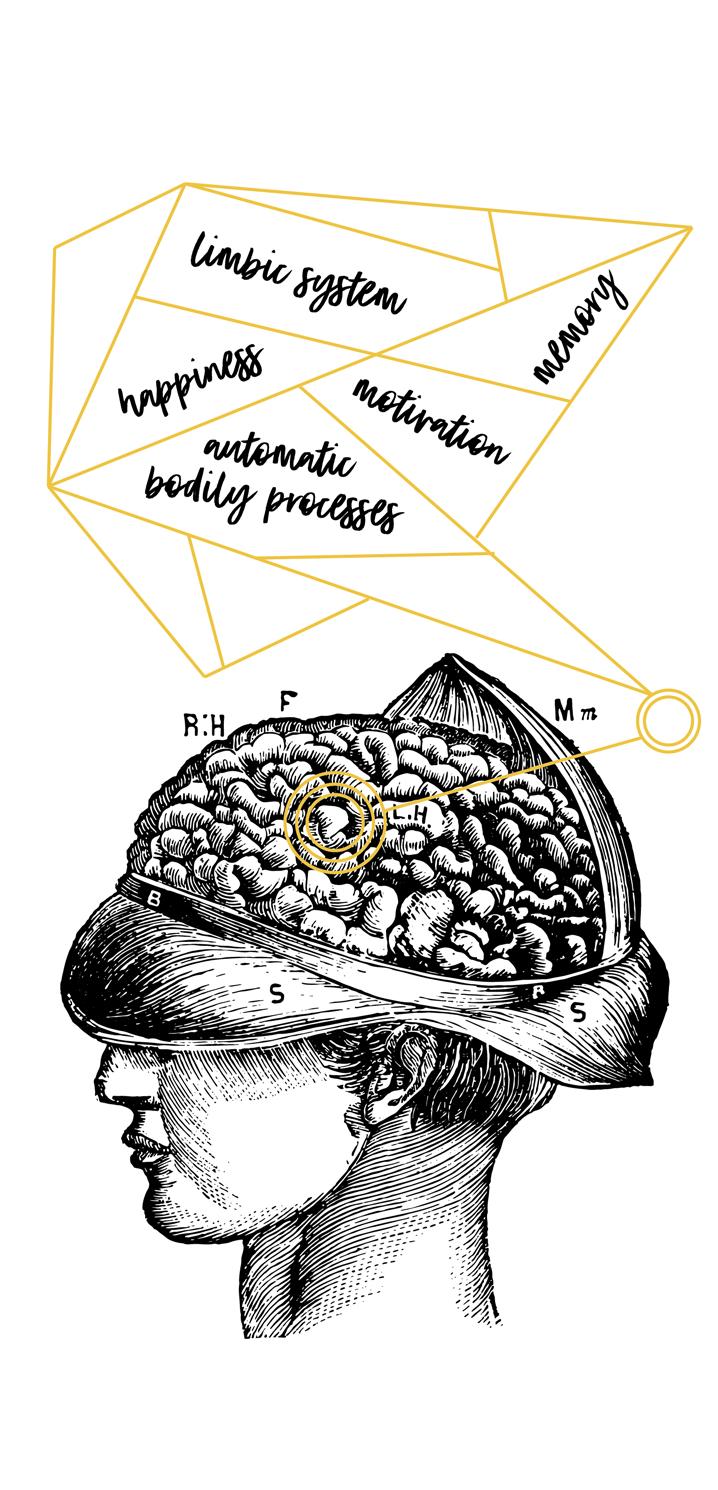
As your Limbo has such an impact on your heart, it’s not surprising people with higher anger scores are two-anda-half times more likely to experience a cardiac event than those who are more placid (Williams et al., 2000). And it’s not surprising the emotional stress of heavy traffic increases the risk of a heart attack in the following hour by a factor of three (Peters et al., 2004). And those butterflies that take flight in your stomach during anxious moments? Scientists are discovering an intimate connection between the brain and the gut. Seventy per cent of your immune system is distributed around your gut (Mayer, 2011), so it’s not surprising an upset gut can negatively influence your health.
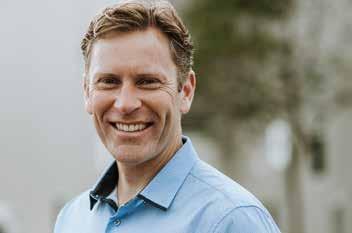


“to adopt a new behaviour for good, you need to discover a way to feel positively about it”
Why do happiness and health promote and complement the other? Because the Limbo is intimately involved in both.
How you feel effects how you heal.
Happiness. Memory. Motivation. Many automatic bodily processes. Hmmm. I hope this is the sound you’re making as

you consider how important it is to look after your Limbo. After all, it’s your body’s emotional hub. Live more happy and it’s likely you’ll live longer.
* There’s some debate among brain scientists about what structures make up the limbic system. I’ll assume the system includes the parrahippocampal gyrus, cingulate gyrus, amygdala, hippocampus, septal nuclei, hypothalamus, olfactory system, sensory association corticies and portions of the thalmus. So glad we cleared that up!

— Dr Darren Morton
Dr Darren Morton is a Senior Lecturer in Health and Exercise Science and Lead Researcher in the Lifestyle Research Centre at Avondale College of Higher Education. He is also author of the books Live More: Active! and Live More Happy

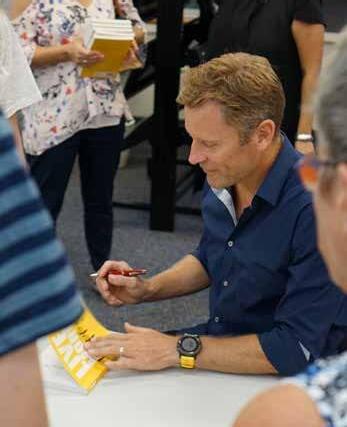
References: Clark et al. (2010). The Brain and Behaviour. Cambridge Press: Cambridge. MacLean P & Delgado J. (1953). Electrical and chemical stimulation of the frontotemporal portion of the limbic system in the waking animal. Electroencephalograph Clinical Neurophysiology 5(1):91-100. Mayer, E. (2011). Gut feelings: the emerging biology of gut–brain communication. Nature Reviews. 12, 453-466. Olds, J., Milner, P. (1954). Positive reinforcement produced by electrical stimulation of septal area and other regions of rat brain. The Journal of Comparative and Physiological Psychology. 47:419–427. Patterson et al. (2011). Change Anything. Piatkus: London. Peters et al. (2004). Exposure to traffic and the onset of myocardial infarction. New England Journal of Medicine. 351(17):1721-1730. Williams et al. (2000).
Anger Proneness Predicts Coronary Heart Disease Risk: Prospective Analysis From the Atherosclerosis Risk In Communities (ARIC) Study, Circulation. 101:2034-2039.
Have you ever wondered how you can keep your brain healthy? Do you know what downshifting and upshifting are when it comes to brain behaviour? And have you ever wondered if there might be a cure for dementia?
On Thursday, 10 March, 4D Living hosted a Brain Function Conference at Noah’s on the Beach in Newcastle. The event was attended by more than 60 people, ranging from those who work in Aged Care to social workers, Allied Health employees, educators and clergy. The opportunity to learn more about the latest research on the brain was too good to resist!
Guest presenters for the Brain Function Conference were Dr Arlene Taylor, a leading presenter on brain function (often referred to as The Brain Guru); Dr Esther Chang, Professor of Nursing within the School of Nursing and Midwifery at Western Sydney University; and Dr Ross Grant, a Biochemical Pharmacologist at the Sydney Adventist Hospital.
Dr Taylor shared tips for dealing with changing the way you think by choosing to engage strategies that help you “upshift”
when you encounter problems or set-backs in life that would typically cause you to “downshift” mentally. She also discussed how to avoid what she terms as “JOT behaviours,” which are jumping to conclusions, overreacting and taking things personally. “I’m so excited I’m still in my career,” Dr Taylor told attendees.
Dr Chang explored the impact dementia has on people worldwide, noting that it’s estimated to become a trillion-dollar disease this year. “There is, in many cases, stigma about mental illness,” Dr Chang noted. “In the case of dementia, it’s the same. People will never tell you, ‘I’ve got dementia.’”
It’s estimated that dementia costs more than $15 billion in Australia, with dementia patients accounting for more than 50 per cent of all residents in aged care facilities. Dr Chang explored some of the many different types of dementia, noting how they all have an impact on the cognitive part of the brain — the frontal lobe. “A lot of Christians say that God talks to them through this area, so to lose that is extremely sad,” said Dr Chang. She also spoke about the impact that alcohol has on the health of the brain, as well as the body.
“people with higher anger scores are two-and-a-half times more likely to experience a cardiac event than those who are more placid”
Dr Grant unpacked the brain-body health connection in greater detail, exploring Alzheimer’s disease and lifestyle links. Alzheimer’s is the most common form of dementia, affecting one in 10 people aged over 65. Dr Grant explored how there are strong links between oxidative stress and Alzheimer’s disease, noting that 90 per cent of dementia and Alzheimer’s cases are not genetic.
“Nine of out 10 people are developing it without a genetic predisposition. A combination of environmental factors account for 90 per cent of what drives the development of Alzheimer’s dementia,” he said, while noting a positive to it — “Aging does not have to mean you’ll develop dementia.”

The best way to boost brain health is to have a healthy wholefoods diet, complemented by exercise, outdoor time, getting enough sleep and activities that stimulate the brain in positive ways.
The conference was part of 4D Living’s focus on promoting health — physical, mental, emotional and spiritual. Attendees of the other programs run by 4D Living were invited to attend, and the event was open to anyone who wished to register.

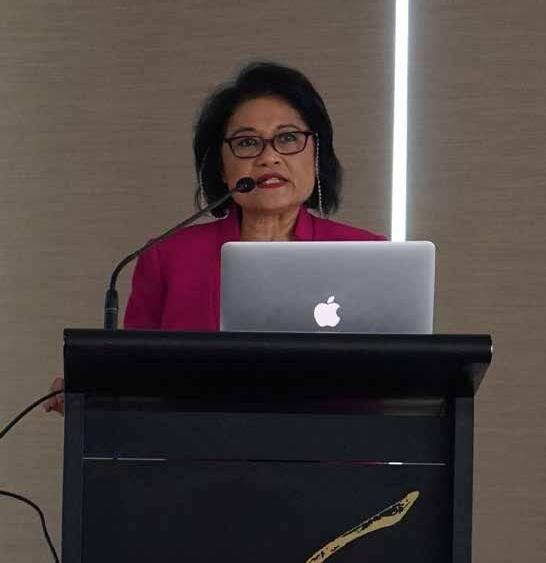
Pastor David Stojcic, who works with 4D Living, says, “It was exciting to have an opportunity like this. The feedback we received was exceptionally positive and people are already
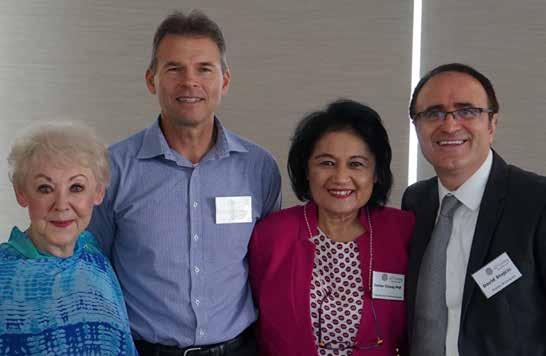
asking when the next one will be held! Our guest speakers were very knowledgeable about the topics they spoke on, and were able to share in a very clear, easy-to-understand way. It was also a wonderful chance to showcase our work, as we shared a 4D Living information pack with each attendee.”
Why does 4D Living run events like this? David says, “We have a couple of reasons. One is to let the community know — both the professional community and general — that we offer programs for them. The second is because we want to benefit professionals and interested parties in the local community.”
Each attendee will be issued with an attendance certificate, which they can use as part of their professional development.
With a focus on spiritual health as an integral component of human wellbeing, 4D Living will run a future conference that explores this in greater detail. “Our approach isn’t new,” says David. “But we do it with no strings attached. It’s a stepping stone toward bring people into the 4D Living community, and we can share a spiritual dimension — the peace that God offers and health for the soul.”
— Adele Nash
“The best way to boost brain health is to have a healthy wholefoods diet, complemented by exercise, outdoor time, getting enough sleep and activities that stimulate the brain in positive ways.”
The sharp eyes of Mrs Branster, member of the Executive Committee of the Seventh-day Adventist Church in Northern New South Wales, spotted the three-hectare property at 112 Lake Road, Wallsend for sale.
It was the mid-1980s and the conference had been seeking to relocate away from its cramped inner-city Newcastle location in Gordon Avenue, Hamilton. A site in the East Maitland area had been investigated, with the location seen as convenient for ministers and staff travelling to various parts of the conference.
Complications with the East Maitland site opened the way for Lake Road to become the preferred option. A special constituency meeting approved the purchase of the Lake Road site and planning for the new Conference Centre began in earnest.
The $1 million construction contract was awarded to the Pluim Group, with the project managed by Graham Allen.
Inside the chapel with Pr Rex Robinson and Thora Arthur — photo credit Joy Guy. Wedding guests in the carpark — photo credit Joy Guy. Inside the original office — photo credit Bob Dale.
Following the sale of the Hamilton site, conference staff moved into the house and shed on the property whilst the office was constructed.
Aub Shirley recalls with a smile the temporary “party line” telephone system operating in the house. Everyone’s phone rang at once with staff progressively replacing their phone receivers if the call was not for them!
Staff happily moved into the new building in December 1987. The Centre was opened and dedicated on 27 May, 1988 with the General Conference President Neil Wilson officiating.

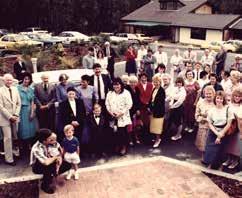
Jeff and Joy (Arthur) Guy were the first couple married in the Chapel on 15 May 1988, thereby sharing a 30th anniversary with the Conference Centre.
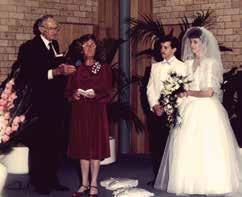 — Joy Guy
— Joy Guy
The church members from The Entrance Adventist Church had also sold their building and voted to amalgamate with Erina Adventist Church. The new congregation was then to be known as Forresters Beach Adventist Church.
Saturday, 3 February saw the last church service to be held in the Erina/Forresters Beach Adventist Church. It was with much sadness that members and visitors filled the church complex for one final photograph.
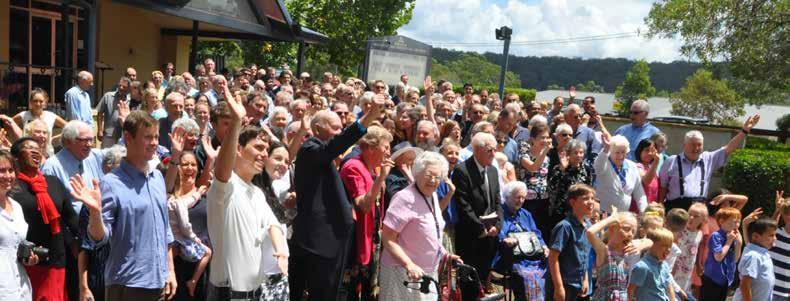
The history of the church began in 1919, when property was purchased to cater to the growing interests in the Erina, Matcham and Terrigal areas. The first building on the current site was built and then dedicated on 12 April, 1919.
Over the years, church members have come and gone, but eventually, with the church’s rapidly-growing membership, a new church was built and dedicated on 18 December, 1976. Some five years later, additional Sabbath school rooms were added. As development encroached around the church and parking became a problem, it was decided in 2015 that the property should be sold.
New land has been purchased at Forresters Beach for the church, but due to difficulties, final approval is yet to be given for the commencement of the building. In the meantime, the congregation is meeting in the Terrigal Uniting Church complex.
The church group asks for your prayers as they negotiate with council for a successful outcome for their building application so they can make a start soon!
— Owen TwistThe Adventist Church plant in Scone celebrated its first baptism on Sabbath, 31 March. Geoffrey was baptised by Stanley Nelson, who ministers to the church plant, with church friends and family gathered to witness the event.
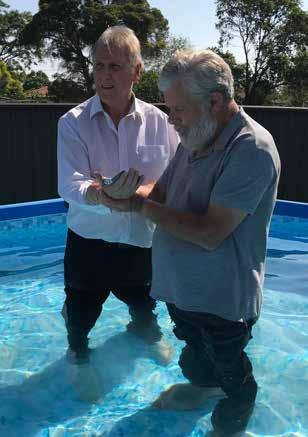
Stanley says, “I had the pleasure of meeting Geoffrey when he came to our ‘Secrets of Prophecy’ series last year. He came every night to hear the Word of God presented. Over the months, I have gotten to know Geoffrey quite well — he’s always there to help and support the ministry in Scone. We’ve met weekly for Bible studies since that time.”
He notes that since Geoffrey joined the church group, he’s quit smoking and drinking. “He’s also on the way to better health through our Depression and Anxiety Recovery program,” says
It’s that time of year when our Grey Nomads from across Australia once again roll into Stuarts Point, bringing with them an incredible camaraderie and enthusiasm for spiritual revival and connection. Here at Adventist Senior Living we were excited to sign up to some of that sense of adventure and join the journey.
The Adventist Senior Living (ASL) - run program of fun kicked off on Saturday evening, 12 May, as we put our Grey Nomads’ trivia knowledge to the test, with four rounds of intense questions, from “whose lips are these” to “who was the first President of the Seventh-day Adventist Church.”
Excitement grew as the tent filled, with groups gathering and connecting to form teams of 10, putting forth some very inventive team names. Tucking into the ultimate brain food of nuts, lollies and liquorice, some 400 campers competed for loads of prizes — including many lovingly made by our amazingly creative Jewells retirement village residents.
The air of competition was enjoyed by all, with plenty of roasting one-liners coming from the floor to keep it real.
“Slow down — I’ve got Grey Nomads on my table,” had to be the line of the night. With prizes every round, there were also smiles all round.
All the fun was backed up with more fun and prizes at the ASL Super Sunday games booth the next day. So many of our trivia participants stopped by to say hi and give thanks for the night before. Keeping the competitive vibe going, our Super Sunday visitors enjoyed Giant Jenga and Connect 4 games — winning more prizes and Adventist Senior Living products. Congratulations to all Trivia winners and Super Sunday visitors.
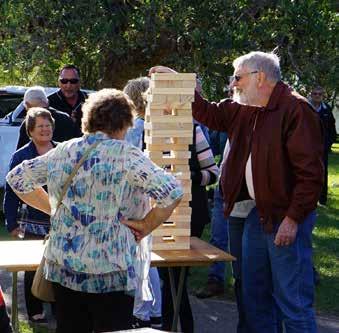

Stanley. “Geoffrey has been such an inspiration to me with his devotion to share the Gospel with others. It’s a pleasure and a privilege to be involved in his decision to be baptised into Jesus and the church.”
Scone Church plant is active in its local community, getting involved in local projects and running a food pantry. The food pantry grew from something run from a house to a shop in the main street of the town. Volunteers from the community are also involved in the church’s food pantry project and there are no limits on who they help.
— Adele Nash
You can connect with Scone Church on Facebook — www.facebook.com/ Sconesda.
While we applaud our winners, true victory was from everyone that had a great time. Thanks for the FUN, Grey Nomads, and thanks for having us! May the joy continue in years to come as you join us in one of our four retirement villages across Northern New South Wales — Avondale, Alstonville, Wyee Point or Jewells.
— Felicity PittawayThe Primary Campus of Avondale School held its annual Run Around Australia event in March, where students try to run the full distance it would take to go around the whole of Australia. But this year’s event had an added feature.
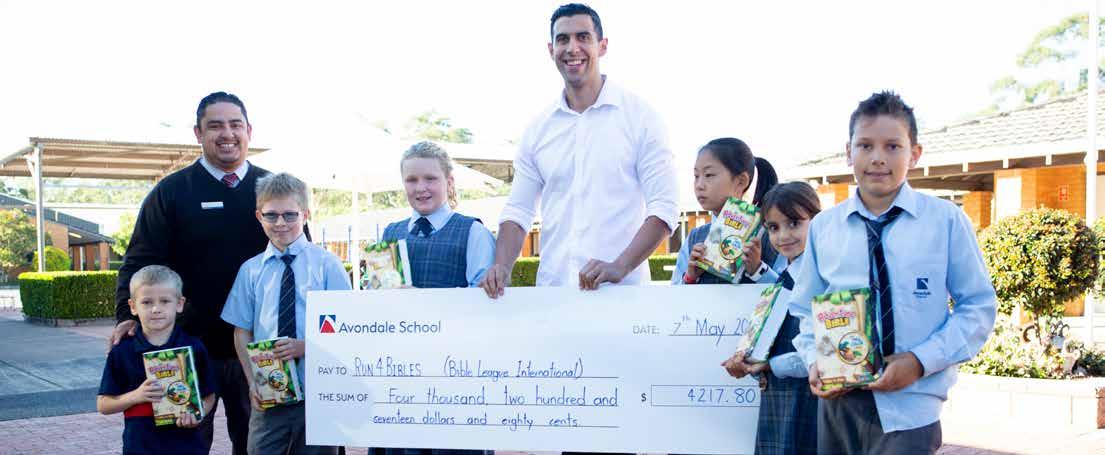
As part of their run, students were invited to raise money for Run for Bibles, a program coordinated by Bible League International, which helps put Bibles in the hands of kids in Africa who may not otherwise have access. The students raised a significant total of $4217.80, which will go to helping spread the gospel to these children.
There were no prizes offered, no extra incentives — just an opportunity to do something that could have eternal significance. But as an added surprise bonus, the six top money raisers were given a special Adventure Bible for their efforts.
Special thanks goes to all the students, staff and those who sponsored them for their support — and for seeing the significance of this program.
— Colin Chuang
As a higher education provider, Avondale College accepts the challenge of learning and discovery, of striving for excellence, and of fostering creativity that blends individuality, wisdom and healthy self-evaluation. It is our goal to develop the whole person — mentally, physically, socially and spiritually.
Teaching Alumnus Josh Brown (pictured, left) shares about being a teacher post his studies at Avondale, saying, “I believe in the power of Adventist Education. As teachers, we have this opportunity to truly get to know our students — who they are, what interests them, their passions and their goals for the future. I see it as a life, as a profession, not as a job. All of it has a sense of purpose about what I’m doing. The young people in my classroom are not just learning English or History. They’re learning how to be an adult in the world. I find that really exciting ... ultimately, teachers are shaping the minds that will become the leaders of tomorrow. If you’re interested in a better society, then teaching is the profession for you.”
Should you choose to come to Avondale for Nursing, Teaching, Science, Business, Ministry or Arts, you will find an affirming community that provides great opportunities for growth, along with a Christian service focus and excellent employment prospects.
Explore Avondale College’s range of VET courses, Undergraduate, Postgraduate and Research degrees, or enquire for 2018/2019 at www.avondale.edu.au.
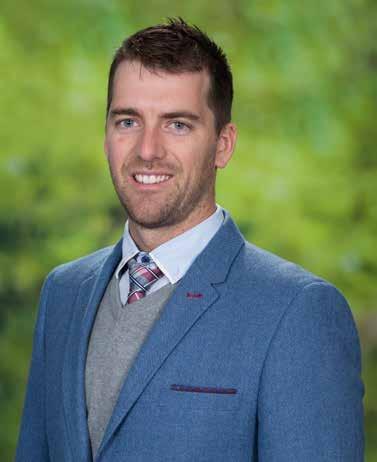
Camila Skaf has recently been appointed as Health Ministries Director for the Seventh-day Adventist Church in Northern New South Wales. She and her husband Joseph have a beautiful baby daughter. They both have a finance background and you might remember reading some of their story in the November 2017 issue of The Upside. But there’s so much more to Camila, who is currently studying a Masters Degree in Lifestyle Medicine through Avondale College of Higher Education! Read on to find out what led her to become so invested in health.
How did you get into ministry?
My family has always been passionate about ministry. My parents are business people, and always did ministry in the evenings or on weekends. Generally, it was health ministry because this is how my mother came to know the Seventhday Adventist Church, leading to knowing Jesus. The church’s health message transformed my mother’s life and since then, our family has been sharing the good news of abundant living with people we care about!
What makes you passionate about health ministry personally?
I love to see real, practical transformations in people’s lives. Health Ministry is about sharing the path to fulfillment and happy living. We have the key to a heavenly life too. Once you taste it, you can’t help but share it, and the more you share it, the happier you are — the taste of that is iconic, really beautiful.
Are there things in your life that have enhanced or refined your health focus?
Yes. I grew up caring for my body and mind, looking after what I put into my body and surrounded myself with. I can see much of my success in life was based on following God’s principles of living. I believe the Creator knows what we need, and being attuned to what He recommends is essential to find fulfillment and joy. Later in life when I worked in investment banking, I constantly ate at the best restaurants in New York City and around the world. I became very interested in the origin of foods and how to prepare an extraordinary meal.
Bad news sells, and unfortunately we can’t avoid it. In the media, our communities and personal lives, we are constantly reminded of things that are going wrong. On the upside, the Bible shows us what can go right and offers hope in seemingly hopeless situations. To learn more, simply post this completed form to receive FREE “The Prophetic Code,” an ongoing series of beautifully-illustrated lessons. Topics include “The secret to Success”, “Life After Death” and many more. Experience this life changing opportunity, obligation FREE, today.

NAME (MS/MISS/MRS/MR):
ADDRESS:
STATE: POSTCODE:
PHONE:

When I took a sabbatical year, I decided to enrol in a professional plant-based chef course. This helped me to focus more on health and clean eating, and brought back all the childhood practices to my day-to-day life.
What’s your favourite experience so far in working to improve people’s health?
Seeing people with a smile on their face and a sense of fulfillment! Just recently, I received a message from a new friend from SEEDS Run Club telling me we had a new member join and they both ran six kilometres that day. I could see her shining face just by reading her message! She ended the message by saying she was amazed at how much her life had changed after she started practicing simple health principles with us. This is the reason why I get up every day!
Do you have any tips for readers who want to start living a healthier life?
I’d love to share what works for me. Just start now. Even if it’s by something simple like drinking more water or walking a few times around the block until your heart rate increases, or just by making breakfast your most special meal of the day. Find a way to start and make it sustainable! The results of small changes will motivate you to take the next step, and before you know it, you’ll be cruising through life in the most positive way! And of course, remember to make sure Jesus is part of your journey. Because when you fall, He is the One who will pick you up and help you get back to your goals.
MY DETAILS
NAME (MS/MISS/MRS/MR):
ADDRESS:
STATE: POSTCODE:
EMAIL:

OR SEND A GIFT SUBSCRIPTION TO SOMEONE SPECIAL (please also fill out your details above)
NAME (MS/MISS/MRS/MR):

ADDRESS:
STATE: POSTCODE:
MAIL TO: The Upside PO Box 7, Wallsend NSW 2287
Get
Simply complete the above and post to our address.
If you need some creativity when it comes to your workouts, give this a go: create your own “pyramid” workout.
Now don’t worry, you won’t need to travel to Egypt and climb the pyramids each day, but it might be similarly tough!
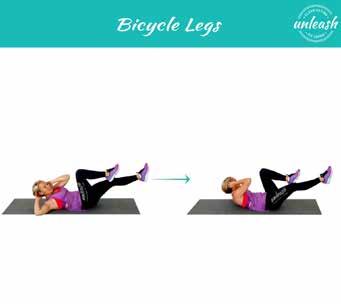
2. Decide how many repetitions you’ll start with, and how many maximum repetitions you want to do so that it increases and decreases — for example: 10, 15, 20, 15, 10
3. Set your timer once you’re ready to start and time yourself to see how long it takes to complete. Complete the exercises as a circuit (e.g. lunges x10, pushups x10, bicycle crunches x10, lunges x15, push-ups x15 and so on)
1 2 3 4
Here’s a ready-to-go full body pyramid workout for you to try:
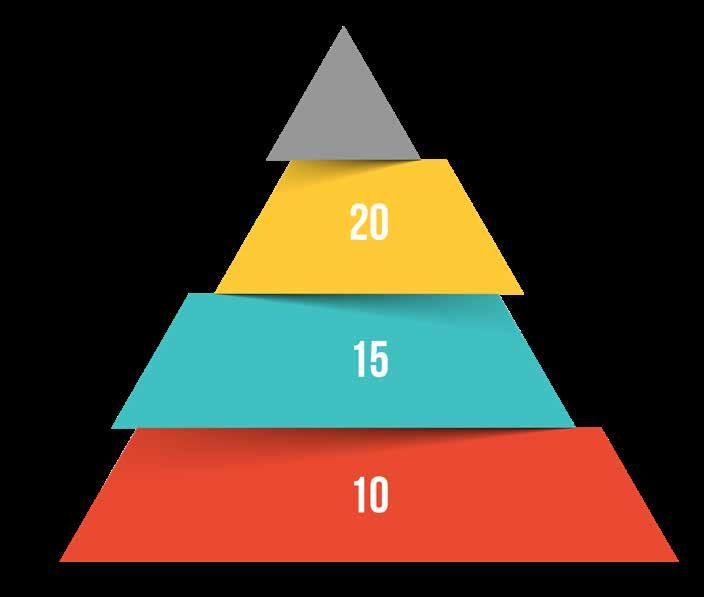
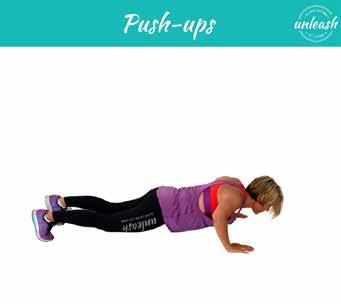



Pearl barley is a nutrient-rich grain. The nutty texture of the cooked pearl barley marries well with the creamy consistency of a risotto. Try it out — you will be pleasantly surprised how easy it is.
Ingredients
– 2 tsp oil

– 2 cups cubed sweet potato
– 1 tbsp oil, extra
– 1 leek, sliced
– few sprigs thyme, removed from stem
1 litre reduced salt vegetable stock
2 cups pearl barley, rinsed
1 cup reduced salt vegetable stock, extra
– ¼ cup finely grated parmesan


– 2 cups baby spinach leaves
– 1 tablespoon pepita seeds
1. Toss cubed sweet potato with oil and place on a baking tray. Bake in a hot oven, 200°C, for 20 minutes or until golden.
2. Heat extra oil in a cast iron pot and saute leek and thyme until leek is tender.
3. Add stock and bring mixture to the boil.
4. Stir through pearl barley and bring mixture back to the boil, then reduce heat and simmer with lid on for 20 minutes, stirring occasionally.
5. Remove lid and add extra hot stock and simmer for remaining 10 minutes with lid off.
6. When pearl barley is cooked, fold through roasted sweet potato, parmesan and baby spinach leaves. Sprinkle with pepitas.
You can subscribe to the Sanitarium Health and Wellbeing Recipe of the Week at sanitarium.com. au/subscribe.
Tip: to make this recipe vegan replace parmesan with 1 tbsp savoury yeast flakes. Share

Acts is undoubtedly the Bible’s most exciting book, as we watch the Holy Spirit transform the wavering and disappointed disciples into a fast-growing movement that continues with you and me today. Exploring this history, Following the Spirit traces the power of the Holy Spirit and dependence on prayer, beginning with the 120 disciples waiting for the promise after Jesus’ ascension.
The Holy Spirit begins a deliberate and dramatic reversal of the curse of Babel, breaking down language barriers at Pentecost in Acts 2 and, throughout the progression of the early church, breaking down many other cultural and ethnic barriers. With a bias for those at the bottom of the Jerusalem class system, the disciples built the gospel movement through the lower city of old Jerusalem. Jesus suffered to save suffering people, so the church ministered to suffering people.
As such, the gospel embraces cultural diversity. The first church plant in Acts is in Antioch, a multicultural church in which many were refugees. It’s usually the disinherited and those on the margins who create gospel movements. We also see that the Holy Spirit included gender diversity in the call to spread the gospel. Consider the ministries of Dorcas, Lydia and Priscilla, or the conversion of the Ethiopian eunuch In Acts 8, whom the Spirit pursued through Phillip and became the church’s first foreign missionary.
Following the Spirit is essential reading, showing the simplicity of sharing Jesus with non-believers and how the Holy Spirit does the heavy lifting on our behalf. Throughout Acts, we see the leaders and believers take the gospel to where the people lived. The identity of churches is not in their size but whether or not they are multiplying hubs of new groups of believers.

While Following the Spirit stands alone as a study of the church in Acts, as a sequel to Following Jesus, it demonstrates how the disciplemaking method of Jesus played out in the life and mission of those first disciples. While Following the Spirit has more explication of the text than did Following Jesus, Dr Roennfeldt’s new book is another prompt to deep study and discussion, ideally suited for use by church leadership teams or small groups, as well as for individual or family study.


— Dr Leigh Rice, leader, Discipleship Ministries Team, South Pacific Division
Before the days of mobile phones, cordless or even attached home phones, tin-can phones were made by many children as a way to talk to each other over some distance.
You can use them just around the yard, or if you have a tree house and one person is on the ground and the other up the tree, or even inside! These are great for planning “secret” missions with your siblings (brothers or sisters) or friends! Your “secret” missions could be planning secret acts of kindness!


Take two tin cans that have no sharp edges and are clean (you can pretty them up with paint, printed duct tape or paper, if you like), a length of string, hammer and a nail.
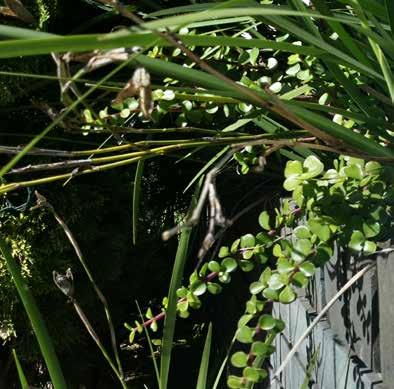
Tin-can phones We connect and communicate with others in many different ways. We chat face to face, on the phone and by email, and we connect with God when we pray.
2 x clean tin cans
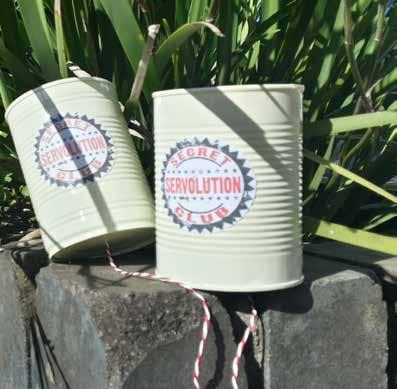 Nail Hammer
Nail Hammer
String Paint or paper for decoration







PHONES 2 4



According to a recent research by Relationships Australia, around nine per cent of Australians suffer from loneliness, and the number of those occasionally experiencing loneliness is around 13 per cent.1 The impact of isolation on health is significant. Those who are lonely are more likely to suffer from depression, report lower levels of self-worth and poor physical health.2
3
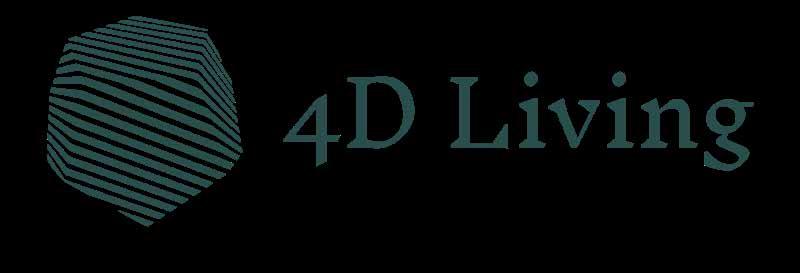
Poke the string through the hole (from the outside of the tin) and tie a knot to keep it inside the can.
Loneliness and spirituality
Does loneliness impact our spirituality? While not every lonely person will get depressed, the risk of depression is much greater for those who are socially isolated and lonely. Loneliness may lead to the loss of meaning/ purpose of life and even to suicide.
What can we do about loneliness?
Analyse your thoughts.
Ask yourself, What do I think about that makes me so lonely? Remember that thoughts create feelings. What do you need to change in your thinking in order to change the way you feel?
For example, we can memorise the Scriptures, such as “I [Jesus] am with you always…” and “Never will I [God] leave/forsake you” (found in Matthew 28:20 and Hebrews 13:5-6).
Immerse yourself in inspirational music.
Do the same for the other can. And there you have it! To use it you will need to hold the string tight so the vibrations can travel down the string. If it’s too windy or noisy outside, it might not work as well, so try to pick a calmer, quieter time of day.
Christian Psychologist Dr Archibald Hart claims “all depressions have spiritual components,” and that “one cannot be depressed, whatever the cause, and not experience some spiritual consequences.”3 This is not a surprise, as depression affects the frontal lobe of our brain — the seat of our spirituality.

Some people can feel lonely in marriage and that also can have an adverse impact on spirituality. According to Christian Counsellor June Hunt, couples often feel spiritually estranged from one another when experiencing marital problems.
Listen to Christian radio; pay close attention to the words you hear; avoid listening to spiritually-oppressive music; sing songs containing Scripture as prayers to God.
Begin attending a group Bible study. Find someone to lead a Bible study in your home if you don’t feel comfortable leading one yourself. Join a small group Bible study with homework or specific assignments requiring you to study the Bible for yourself. Start a weekly group, encouraging one another in common areas of interest or concern. Share biblical encouragement for every problem. Do a Bible study online with a friend/group of friends and hold each other accountable.5
NB: Because you need a hammer and nail, check with an adult first before starting on this.
By Michelle Villis, AmeliaShe says, “Living with someone — married or not — does not insure emotional intimacy or security in the relationship.” The reason for this is the fact that “many couples are not emotionally connected because they do not share their dreams or desires, their trials or temptations, their hurts or hopes. They fail to listen to one another and merely share the roof over their heads.”4
The bottom line is we do not need to be lonely. God doesn’t want us to be lonely. He said it is not good for man to be alone (Genesis 2:18, NIV). As we mingle with other people, we learn to love, give and receive. We learn to be balanced. We need other people in our lives and there are plenty of people out there who are looking for friendship.
1 https://www.relationships.org.au/what-we-do/research/online-survey/
